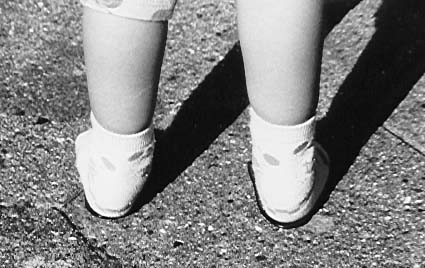| Flat-footedness is a number of
different conditions all caused by the absence of the arch
in the foot. The front of the foot is turned outwards. The
outer edge is further out than the lateral malleol.
There is a distinction between a mobile and a rigid flat. In
the mobile state the foot arch will appear when the patient
is standing on his toes. In the rigid state the arch
does not even appear when there is no strain on the foot.
The causes of flat-foot can be
A. Idiopathic (unknown)
B. Too short an Achilles tendon
C. Muscular tibialis posterior
D. Polio
E. Rheumatoid arthritis
F. Injury
G. Coaliton
H. Fibrous rigidity.
A.
The idiopathic condition, as the name indicates, is of unknown
cause. It is often a milder case of flat-foot that will not
give trouble later in life.
B.
The foreshortened Achilles tendon is the most serious. In
a few years it can turn a mobile foot into a rigid one with
subsequent problems in running and walking. In the first
years of a child's life there is degradation of the medial
ligaments of the foot from the navicular bone to the metatarsus. Extension
of the ligaments is permanent. The foot cannot be re-stationed
later. It will continue to fall back into the valgus
position. It is therefore important for the condition
to be discovered as soon as possible in order for appropriate
treatment to be begun.
This condition is observed when the foot cannot be placed
at a right angle with the leg stretched and the foot slightly
in adduction ad supination.
If this condition is discovered before any irreversible damage
is done, positive results can be obtained by both conservative
and operative methods.
Conservative: Treatment should consist of raising the heel
so that the foot is not forced into the valgus position. Often
it is a matter of a rise of 2-3 centimetres. When the
foot is kept in this position, it is unnecessary to adjust
the foot arch later on. Correct design can make it almost
invisible to others. This cosmetic consideration is especially
important to the young.
Operative: Treatment by this means consists of elongation
of the Achilles tendon. Similarly a 2-3 centimetre elongation is
to be aimed for. As with conservative treatment adjustment
of the arch is unnecessary later on. It is often difficult
to get a satisfactory balance between footwear and arch support. This
calls for intensive work by al the therapists involved.
C.
Inadequate functioning of the musculus tibialis posterior
is the most common form of flat-footedness. In some it
is congenital. Others acquire it at other stages in life.
It shows itself as the foot sinks in the standing position
and patients begin to walk "Chaplin"-like. Asked to
stand on their toes it is only with difficulty that they can
manage to show an arch.
Those who later in life rupture an arch cannot show an arch
at all.

L. Schoite modification.
R. Standard support.

L. Schoite modification. R. Standard
support.

L. Standard support. R. Schoite
modification.

L. Standard support. R. Schoite modification.
Treatment
is a Schoite modified arch support.
Standard arch supports are unable to support the foot adequately. If
the feet are adjusted sufficiently, normal athletic running
is possible at normal speeds.
D.
In the case of polio none of the muscles maintaining the foot
arch work causing it to fall down. Foot orthosis can
be performed, the normal position of the bones in the foot
maintained preventing wrong positions and possible associated
pain.
E.
Rheumatoid arthritis causes the ligaments in the foot to become
too weak and the resultant slipping apart of the bones. At
the same time pain, when moving the foot, causes immobility
of the articuli in the foot which therefore weaken. Treatment
consists of individually designed supports to relieve the
pressure on the foot. This can be performed by a podiatrist.
F.
Injuries, either to the ligaments and muscles in the foot
or to the nerves leading to the foot, can cause flat-footedness. In
such cases treatment should be directed at the incorrect foot
positions by individually designed supports and by orthosis.
G.
Coalition of the bones in the foot can be treated by removing
the coalition operatively.
H.
Fibrous rigidity flat-foot is a combination of different conditions
characterised by the foot no longer being able to produce
an arch when standing on tiptoes.
It causes different conditions, one of which is osteorthosis
in the tarso-metatarsal joints. This is difficult to
treat. Early treatment should be considered whilst the
foot is still redressible.
Pain is found commonly in the lateral malleol (impingement),
or in the medial malleol (distraction of ligament). Both
conditions can often be helped with a shock-absorbing arch
support. |

